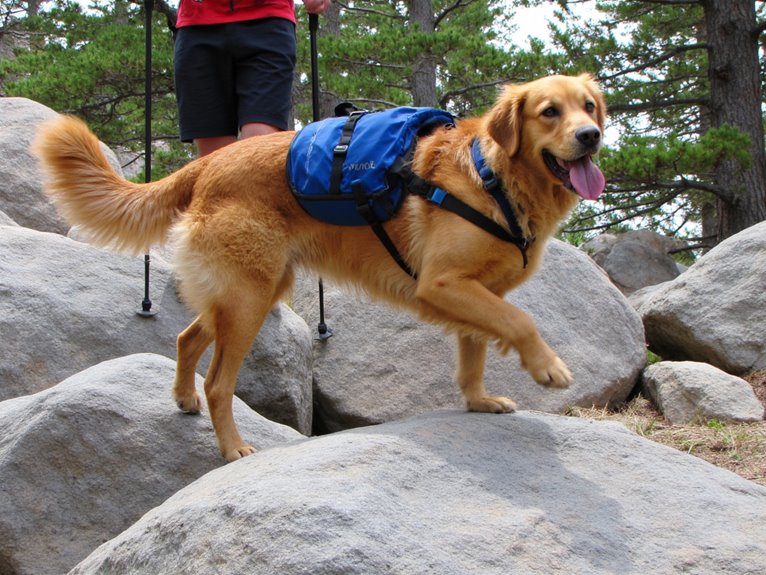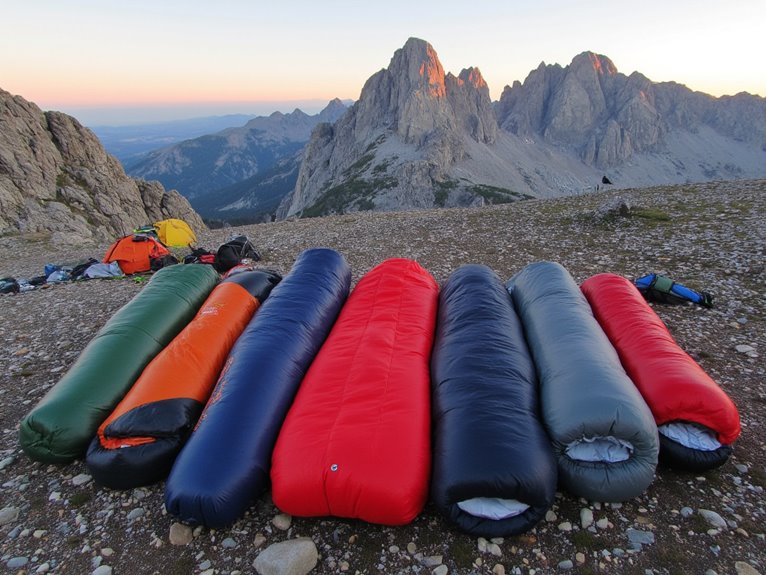Backpacking With Dogs: Training, Gear, and Trail Considerations
Start conditioning your dog with 90-minute hikes, increasing duration by one hour weekly while following the 10% mileage rule. You’ll need a properly fitted backpack with eight adjustment points, ergonomic spine support, and padded chest plates for gear distribution. Provide 8 ounces of water hourly and pack dog-specific first aid supplies including antiseptic wipes and gauze pads. Train essential commands like “over” and “under” for trail hazards while researching leash laws and seasonal restrictions. Master these fundamentals to access advanced techniques for multi-day wilderness adventures.
We are supported by our audience. When you purchase through links on our site, we may earn an affiliate commission, at no extra cost for you. Learn more. Last update on 8th January 2026 / Images from Amazon Product Advertising API.
Notable Insights
- Start with 90-minute hikes and gradually increase duration by one hour and elevation by 1,000 feet per session.
- Choose dog backpacks with eight adjustment points, ergonomic spine support, and padded chest plates for proper weight distribution.
- Provide 8 ounces of water per dog hourly and pack high-energy foods for frequent snacking during hikes.
- Carry comprehensive first aid kits and monitor breathing, heart rate, and paw condition throughout the trek.
- Research trail regulations including leash laws and seasonal restrictions while training dogs for wildlife encounters and terrain hazards.
Building Your Dog’s Endurance and Trail Skills

When you’re preparing your dog for backpacking adventures, building endurance requires the same methodical approach you’d use for your own fitness training.
Start with 90-minute to 2-hour hikes to establish baseline conditioning. Increase duration by one hour and elevation by 1,000 feet per session while maintaining the 10% weekly mileage rule to prevent overexertion.
Endurance drills should begin on flat terrain at 15-minute-per-mile pace before progressing to steeper grades. Schedule a minimum of three weekly sessions to avoid weekend warrior injuries.
Terrain acclimation develops gradually through exposure to increasingly challenging conditions.
Maintain your dog’s body condition score at 5 out of 9 for ideal stamina. Monitor paw integrity after each session, using protective boots during initial rugged exposures.
Recovery periods between training sessions allow muscle adaptation and joint healing. Just as fleece jackets provide versatile layering options for transitional seasons, your dog may benefit from lightweight protective gear during varying weather conditions on training hikes.
Preparing Your Canine Companion for Extended Adventures
Successful multi-day backpacking with your dog demands thorough preparation that extends far beyond basic fitness conditioning.
Trail acclimatization strategies begin with progressive exposure to varied environments. Start with overnight camping trips to establish your dog’s comfort with sleeping outdoors and unfamiliar sounds. Introduce weighted pack training gradually, beginning with 10-15% of your dog’s body weight.
Start small with overnight trips and gradually add pack weight to build your dog’s confidence and endurance.
Grooming tips become critical for extended adventures. Trim excess hair between paw pads to prevent debris accumulation. Check and clean ears daily to prevent infections from moisture and dirt. Pack portable grooming tools including nail clippers and a slicker brush.
Practice emergency scenarios including river crossings and wildlife encounters. Train recall commands consistently in distracting environments. Your dog must respond immediately to voice commands and whistle signals for safety in remote terrain.
Must-Have Equipment for Dog Backpacking Trips
Your dog needs specialized gear to safely carry supplies and stay comfortable during multi-day backcountry trips.
Three essential categories form the foundation of canine backpacking equipment: properly fitted carrying systems that distribute weight across your dog’s body, reliable hydration and feeding solutions for trail nutrition, and thorough safety gear including first aid supplies.
Each piece of equipment must meet specific technical requirements while maintaining minimal weight to guarantee your dog’s performance and well-being on challenging terrain.
Consider selecting a human companion pack with hydration compatibility features, as integrated bladder systems allow you to easily share water with your dog during rest stops without disrupting your hiking rhythm.
Dog-Specific Backpacks and Harnesses
While standard hiking gear gets most of the attention, your dog’s specialized equipment can make or break a backcountry adventure.
Dog backpacks require eight adjustment points for ideal harness fit, distributing weight evenly across your dog’s frame. Quality packs feature ergonomic spine support and padded foam chest plates that conform to your dog’s body structure, preventing chafing during extended hikes.
Essential features for trail-ready dog gear:
- Adjustable belly straps – Prevent pack slippage on steep terrain and provide escape-proof security
- Built-in sturdy handles – Enable quick lifting assistance over obstacles and difficult trail sections
- Reflective trim components – Increase visibility in dense vegetation and low-light conditions
- Load compression straps – Maintain balanced weight distribution and prevent gear shifting during movement
Reinforced stitching withstands rugged outdoor conditions while modular compatibility allows detachable storage expansion. Consider adding protective headwear with UPF 50+ ratings for dogs during prolonged sun exposure on exposed alpine trails.
Hydration and Feeding Essentials
Once you’ve equipped your dog with properly fitted gear, maintaining adequate hydration and nutrition becomes the foundation of safe backcountry travel.
You’ll need 8 ounces of water per dog hourly during hiking activities. The Ruffwear Singletrak Hydration Pack features removable Platypus reservoirs, enabling dogs to carry their own water supply independently.
Collapsible water bottles offer space-efficient portability for extended trips. Choose leak-proof designs with carabiner clips for secure backpack attachment. Research water availability along your planned route, as natural sources may be unreliable in arid environments.
Food preparation requires advance planning based on your dog’s size and activity level. High-energy foods sustain performance during strenuous hikes. Store meals in sealed containers within organized backpack compartments.
Frequent snacking maintains energy levels throughout demanding terrain. For extended backcountry trips, consider packing an emergency radio to stay informed about weather conditions and potential hazards that could affect your hiking plans.
Safety and First Aid
When emergencies strike on remote trails, an all-encompassing first aid kit becomes your dog’s lifeline to safety and recovery.
Proper injury prevention starts with carrying essential medical supplies in a waterproof, 9-ounce tactical pouch. Your kit must accommodate both human and canine needs while remaining lightweight and accessible.
Essential first aid components include sterile gauze pads, self-adhering bandages, and antiseptic wipes for wound treatment. Dog-specific tools like slip leads, tick removers, and styptic powder address canine emergencies effectively.
Critical backpacking first aid items:
- Irrigation syringe (10cc) – flushes debris from wounds using sterile saline
- Emergency blanket – prevents hypothermia in injured or shocked dogs
- Blunt trauma scissors – safely cuts bandages without injuring fur or skin
- Instant cold pack – reduces swelling from sprains or impact injuries
Before setting foot on any trail with your dog, you must research and understand the specific regulations governing that area, as these rules vary markedly between National Parks, state parks, national forests, and local trail systems.
Leash laws typically restrict length to six feet maximum, particularly near trailheads. Some trails permit off-leash hiking only under strict voice and sight control.
Trail etiquette demands yielding uphill hikers by stepping aside carefully. Your dog shouldn’t approach other hikers or animals without permission. Maintain 200-foot distances from water sources and pack out all waste.
Seasonal restrictions often protect wildlife during sensitive periods.
Check park websites or ranger stations for current regulations before departure. Many areas completely ban dogs from certain trails, making compliance research essential for successful backpacking trips.
Managing Distractions and Challenging Terrain
As trail conditions become more complex and wildlife encounters increase, your dog’s training and preparation directly determine whether challenging terrain becomes a manageable adventure or a dangerous liability.
Proper conditioning prevents injuries and builds confidence across varied surfaces.
Gradual exposure to different terrains builds your dog’s physical resilience and mental confidence for safer trail adventures.
Training prevents dog distractions from derailing your hike:
- Command mastery: Teach “over,” “under,” and “stay” commands before encountering trail hazards like fallen logs or rocky passages.
- Terrain conditioning: Gradually expose dogs to grass, gravel, rock, and sand surfaces to reduce sensory overload and improve focus.
- Wildlife protocols: Train calm behavior around livestock and wildlife to prevent dangerous chasing incidents that compromise safety.
- Physical preparation: Build stamina through progressive distance increases, starting with short walks to condition muscles and prevent overexertion injuries.
Monitor paw pads continuously and use protective booties on abrasive surfaces. Just as hikers benefit from moisture-wicking socks to prevent blisters and maintain foot health, dogs need proper paw protection during extended outdoor activities.
Keeping Your Dog Healthy and Clean on the Trail
Trail health management requires the same systematic approach you’ve applied to terrain training, but focuses on maintaining your dog’s physical condition and cleanliness throughout the journey.
Monitor your dog’s breathing and heart rate during breaks to assess hydration status. Excessive panting demands immediate water and rest. Pack purified water exclusively-untreated streams carry giardia and leptospirosis risks.
Post-hike dog grooming sessions remove accumulated dirt, debris, and parasites. Inspect fur thoroughly for burrs, foxtails, and ticks that cause irritation or secondary infections.
Check paws between toes for lodged thorns and plant material. Remove ticks promptly using proper techniques to prevent disease transmission.
Parasite prevention includes vet-approved treatments applied before departure.
Watch for limping, excessive fatigue, and heat exhaustion symptoms including heavy panting, drooling, or uncoordinated movement.
Consider your dog’s sleeping arrangements in advance, as dogs require proper insulation and warmth just like humans, particularly in conditions where temperature ratings drop significantly below expected weather patterns.
Frequently Asked Questions
At What Age Can Dogs Start Backpacking Training?
You can start backpacking training when your dog reaches two years old for medium to large breeds.
Puppy readiness varies by size: small breeds mature around 12 months, while large breeds need 18 months for growth plate fusion.
Training milestones begin with empty pack familiarization during puppyhood, progressing to loaded packs only after skeletal maturity.
You’ll prevent long-term skeletal injuries by waiting for complete bone development.
Which Dog Breeds Are Best Suited for Backpacking Adventures?
You’ll want active breeds with proven endurance like German Shorthaired Pointers, Vizslas, and Australian Cattle Dogs for demanding trails.
Medium to large dogs such as Labradors and Siberian Huskies can carry gear while maintaining stamina.
Essential temperament traits include high trainability, loyalty, and low prey drive.
Border Collies and Australian Shepherds excel due to intelligence and focus.
Avoid breeds with joint issues or extreme temperature sensitivities.
How Much Weight Can My Dog Safely Carry in a Pack?
Your dog’s safe weight limits depend on body weight and fitness level.
Never exceed 25% of body weight, but 10-15% is safer for most dogs. A 50-pound dog should carry 5-7.5 pounds maximum.
Start with lighter loads during pack training sessions. Gradually increase weight as your dog builds endurance.
Monitor for limping, excessive panting, or reluctance to move, which indicate immediate weight reduction is necessary.
What Are Signs My Dog Is Too Tired to Continue Hiking?
Watch for specific fatigue signals during your hikes.
Your dog’s excessive panting that doesn’t resolve, sudden lying down, or lagging considerably behind indicates exhaustion.
Behavioral changes like ignoring commands, reluctance to continue, or seeking shelter signal overexertion.
Take immediate hiking breaks when you notice labored breathing, stumbling, or loss of interest in surroundings.
Post-hike symptoms include extended sleep periods and general sluggishness lasting days.
Should I Bring Special Sleeping Gear for My Dog When Camping?
You should bring an insulated pad for your dog when camping. A closed-cell foam pad like a Z Lite provides essential ground insulation and withstands dog nails better than ultralight options.
Add a sleeping bag for cold or damp conditions, as fur alone isn’t sufficient. Choose synthetic insulation for wet environments.
Test gear at home first to guarantee your dog will use it.
On a final note
You’ve gained the essential knowledge for successful dog backpacking adventures. Your canine companion’s endurance, proper gear selection, and trail safety awareness form the foundation for memorable wilderness experiences. You’ll navigate regulations confidently while managing distractions and terrain challenges. Maintaining your dog’s health and cleanliness guarantees extended trip success. Start with shorter distances, gradually increase difficulty, and always prioritize your dog’s well-being. You’re ready to explore trails together safely and responsibly.




